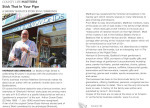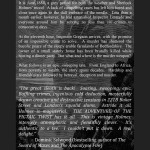M.J.H. Simmonds's Blog
July 13, 2024
The Mystery of Cranfield Court – A (little) Local Holmesian Mystery Solved
“There’s a man here asking if he can speak to the Conan Doyle expert,” announced my cousin, leaning into my office.
“Well, I would certainly not call myself an expert, but I am happy to have a chat with a fellow Conan Doyle enthusiast,” I replied, rising from my chair, grateful for an excuse to stretch my legs.
I most fortunate to own, along with my cousin, the family business – a fifth-generation tobacconist and gift shop situated on Bedford’s High Street. My days are now mainly spent working on our ever-more essential online presence, but we are still visited by many friendly, regular customers and a good number of interesting characters from far and wide.
I passed from my office into the shop itself and greeted our latest visitor. He introduced himself as a retired farmer who once worked the land up near Cranfield, a village about nine miles southwest of Bedford. He proceeded to recount a most interesting tale.
About twenty, or possibly even thirty, years ago he was working in the fields near where Cranfield Court used to stand when he saw a private coach approaching. He was surprised when the bus pulled up nearby and even more so when all of the passengers from the coach disembarked and began to wander around the site of the old building. The imposing main residence and all of the original outbuildings had been demolished some decades earlier, just a couple of early twentieth-century cottages remain on the site.
He watched as the visitors, perhaps two dozen in number, snapped pictures and took notes as they excitedly explored the area. He strolled over and reached the group just as they were re-boarding the bus. He asked what the reasons were for their visit to the Court and from the various overlapping replies he remembers hearing the names ‘Conan Doyle’ and ‘Sherlock Holmes’.
The old farmer naturally assumed that the site must have some importance or relevance to one of Arthur Conan Doyle’s Sherlock Holmes adventures and thought little more of the event for some time. After a while, the farmer became more aware of the Sherlock Holmes ‘canon’ but never found a mention of, or allusion to, Cranfield Court in any of Doyle’s stories.
That morning, as he walked past our shop, he spotted the copies of my own Sherlock Holmes adventures that sit in the front window display, among the assorted pipes, pocket watches, hip flasks and fine diecast models of wartime aircraft and exotic automobiles. It transpires that he was already aware that a Holmesian author worked at the shop and our little display had reminded him of the singular event that had puzzled him those many years ago.
We were certainly intrigued by his tale, although I had to quickly admit that I knew of no mention of a Cranfield Court in any of the Sherlock Holmes stories. My cousin, though, had been diligently tapping away on his mobile phone, searching for any connection between Cranfield Court and Sherlock Holmes. His quest proved fruitful, and he announced that he had found the answers to the questions posed by our new friend.
In The Adventure of the Blanched Soldier (1926), the location of Tuxbury Old Park is described as being near Bedford – “Tuxbury Old Hall is inaccessible – five miles from anywhere.” Bernard Davies, erstwhile Chairman of the Sherlock Holmes Society, had identified Cranfield Court as being the true location of Tuxbury Old Park. He had divined this from descriptions of the railway station, maps and rail timetables.
Whether or not Davies is correct, we will probably never know for sure. However, we can now be certain of the reason why two dozen Sherlock Holmes fans descended on an obscure, mostly empty, field in Bedfordshire – much to the bemusement of a colourful and amicable local farmer.
February 4, 2024
The Vanishing Man (Or The Railway Arches Mystery) – A New Short Story
The Vanishing Man (Or The Railway Arches Mystery)
© 2024 M J H Simmonds. All Rights Reserved
“Look at the date, Watson,” exclaimed Holmes, a long, pale finger pointing to the top of the morning newspaper.
“It is Monday, the third of November, 1902, what of it? How is the date relevant to the case?” I replied with a sigh, knowing full well that I would shortly have my answer.
“Please recount what we so far know of the affair please, Doctor,” ordered Holmes.
“Very well. It was late last night or, rather, early this morning. A young constable observed three young men entering a lockup garage under one of the railway arches on Pedley Street. He became suspicious as they appeared to be under the effect of drink. Two of the men held each other up while the third worked at the door until it opened. Believing that they were breaking in, the policeman ran towards them and watched as they swiftly dashed inside the small dark recess, slamming the door closed behind them.”
“Upon reaching the lockup, the constable pulled open the heavy door and shouted to the men that they were under arrest. He grabbed at the nearest rogue but one of his companions pushed him away and the two men fled out into the night. The constable quickly decided that his best option was to attempt to apprehend the third man. He swiftly closed and bolted the door behind him and turned to face the final intruder, truncheon held aloft. However, he was astonished at what he saw before him. The small room was empty, the last man was nowhere to be seen. A nearby street gaslamp let in enough light for the young policeman to be certain that he was quite alone. Three of the walls were solid brick, the only point of entry or exit was through the door behind him. All that lay on the floor were some rags and a pile of dirty straw. He, and latterly his colleagues, carefully examined the walls and all were found to be sound and secure.”
“You saw the poor man, yourself, just a few hours ago, Holmes,” I stressed. “He was at his wit’s end.”
“The area was relatively well lit and he insists that only two men pushed their way past him. He has nothing to gain from this affair, he could just as easily never have mentioned it to anyone, yet he chose to confide in us. I can see no rational explanation for this mystery. Three men entered that room but only two ever left it,” I concluded.
“The date tells you all, dear fellow. That and the heavy boots of the constable and his fellow policemen,” replied Holmes with a sigh. He was already becoming bored, having solved the case in his head.
“The date? Let me think. November the third, what is special about this time of year? Wait a moment, it is just two days from Guy Fawkes Day, or ‘Night’ as the firework makers seem to be calling it these days.”
Holmes nodded slowly, so I continued, hoping that I would somehow stumble across the answer.
“What else? Firework displays, large-scale drunkenness, public unrest and even rioting have been associated with this date.” Holmes shook his head to indicate that I had not yet made the essential connection.
“On a more innocent note, children dress up a figure as Guy Fawkes and parade their creations through town, asking ‘a penny for the Guy’ before placing the effigy atop a large bonfire later that night and burning poor old Guy Fawkes to cinders once more.”
“The Guy” I exclaimed, excitedly. “Ha, that is it! Why, of course it is. It was never three men, it was two men carrying a straw-filled effigy of the would-be destroyer of parliament. They must have entered the lock-up, thrown down the dummy and then been surprised by the policeman bursting in unannounced. In the ensuing melee, the men escaped but the dummy was trampled upon and reduced to rags and straw. The constable’s colleagues stomping around later would have rendered the effigy unrecognisable, just part of another dirty industrial floor.”
“Well, I never, old man, what a remarkable incident.” I shook my head in disbelief and tamped down the tobacco in my bowl. Pulling a taper from the fireplace, I lit my fine Rhodesian briar before passing it to Holmes to apply to his hideous, dirty black churchwarden.
“Never fail to make a note of every conceivable detail, Watson, or fail you will,” commented Holmes, settling down for an evening of pipe smoking and contemplation.
January 29, 2019
Better The Devil – A Short Story
Better The Devil
© 2016 M J H Simmonds. All Rights Reserved
“The waiter, of course!” declared Holmes, with obvious agitation. “Really, inspector, you bring me cases a child could solve.”
“But we searched everyone, and he had absolutely nothing on him. No trace of having carried any poison, and anyway, why on earth would he do it? He did not even know the man. He had only been in the country for a week or two, and as far as we can ascertain, they had never even previously met.” Inspector Lestrade defended himself staunchly against Holmes’ verbal assault.
Holmes sighed. “The poison was spent. It had achieved its purpose. What kind of assassin would carry with him, extra poison? Did he have a list of intended victims and this poor devil was merely the first?”
Holmes’ sarcasm was met with silence from a reddening Lestrade.
“At least you examined the flowers,” Holmes added, resignedly. Lestrade opened his mouth to reply, but stopped and said nothing.
“Oh Inspector, did you not look into the vases? If I were to pour poison into a man’s drink, I would want to be rid of the sachet that contained the hateful powder as soon as I possibly could. Crushing it in hand and dropping it into a flower vase could be achieved almost in the same motion as adding the poison to a glass of wine. Remember, Lestrade, the victim never left the table. The only moment when he would have been blind to the waiter was when he held the menu before him, an oversized single sheet of card, which would have momentarily blocked the waiter’s lower half from view. It would have appeared as if the waiter was simply moving the vase into a more convenient position when he was, in fact, administering the fatal dose and also disposing of the pouch which held this terrible agent.”
“Well, all this is merely speculation,” stammered Lestrade. “Even if we find said sachet in the vase, we still have no motive for the crime. Look, Holmes, nobody saw what happened, so without a motive, or any witnesses, we have to accept that we are unlikely ever to get a conviction, everything else is circumstantial.”
“But we do have more data, Inspector,” Holmes countered. “What was the victim’s name?”
“Let me see.” Lestrade examined his notebook. “Luca Cinquemani.”
“And the waiter?”
“Francesco di Trapani. Yes, I do realise that they were both Italian. However, that is hardly surprising, it is an Italian restaurant, after all,” Lestrade responded, with more than a hint of a sneer.
“And, anyway,” he added with a trace of triumphalism, “Cinquemani, despite his fancy name, was born and bred in the East End of London. He was as local as you or I.”
“Inspector, what do you know of the island of Sicily?” Holmes asked, calmly.
“Well, not a great deal,” struggled Lestrade. “There is much talk of secret societies and vendettas, but that is surely of no relevance here, is it?”
“What if I told you that Cinquemani is an old Sicilian name, literally meaning ‘five hands’? It was a name often given to the families of thieves.”
“Thank you for the lesson in history, Mr Holmes, but a man’s surname is hardly proof of guilt or, indeed, a reason for murder,” replied Lestrade, gruffly.
Holmes ignored Lestrade’s tone and continued. “Trapani is a fishing port on the west coast of Sicily. Coincidences do certainly occur and, yes, many are innocent. However, when a crime has been committed, all deserve, and indeed require, investigation.”
“So, we have a connection. I admit, Holmes, I am impressed, but I still do not have enough to charge the waiter.”
“Nor, I suspect, will you ever have,” announced Holmes, to our complete surprise.
“Really, Holmes,” spluttered Lestrade. “I thought you were certain that the waiter was our man. What on earth has changed your mind so suddenly?” begged Lestrade.
“Why, Inspector, I must apologise. While I am indeed certain that di Trapani is indeed the killer, I, like you, can offer no absolute proof. I am also frustrated that this murder may well go unresolved and a killer will most likely walk free. My only solace is in my, admittedly scant, knowledge of Sicilian affairs. If a man has made the effort to travel one and a half thousand miles to commit a murder, then it must surely have been for a good reason.”
“To kill a man,“ Holmes continued, “essentially in public, is a huge risk and therefore has to have been done for a good reason. It was carefully planned and, please forgive the expression, executed. This whole terrible business had two purposes. Firstly, to make a statement, to demonstrate that, wherever one may try to run, anyone, anywhere can be reached. This is very much a signature of Sicilian killings. Secondly, this was almost certainly a revenge killing. Sometime in the past, Cinquemani was, almost certainly, responsible for an outrage that personally affected di Trapani or his family. The young man has probably long plotted his revenge and, once he was able, ventured here to London where he finally exacted his revenge.”
“Be that as it may, we still have an unsolved crime here. How do you suggest we proceed?” asked Lestrade, all hint of sarcasm now long gone from his voice.
“I suggest that we each take a large brandy and one of Watson’s excellent Hoyo de Monterrey cigars, newly arrived from H&S.”
Holmes’ reply was as shocking as it had been unexpected.
“Do you mean that we should do nothing, Holmes?” I asked, incredulously.
“Anything that we now do can only lead to more suffering and, very possibly, even death,” Holmes replied, seriously.
“We have stumbled across a crime of revenge, one which will be protected by the sworn oath of ‘omerta’. Any, and all, of our future investigations would be in vain. We would only be risking our own lives, and those of others, with no possible hope of success,” continued Holmes.
Lestrade left shortly afterwards, refusing the offer of both brandy and cigar. I was also in no mood to relax with a drink and a smoke and turned on Holmes once we were alone.
“Sometimes, Holmes, I simply do not understand you. How can you let a killer escape so easily?” I demanded.
Holmes sighed, sadly. His face seemed to drop and he suddenly appeared to gain many years as he slumped back into his chair.
“My dear Watson. I do not always communicate with you all that I know. Sometimes for selfish reasons, but occasionally because I fear exactly what you would do if you knew the whole truth.”
“Holmes, old chap, you can tell me anything. You know that,” I replied, not a little hurt at Holmes’ admission.
“Very well. There have been rumours circulating regarding the activities of Cinquemani, for some time. Nothing approaching actual proof has ever been forthcoming, although that is no surprise in such a tight knit community. However, the rumours have persisted.”
“By God, what sort of rumours, Holmes?” I could barely dare to think of what terrible things might cause even Holmes to baulk at their very existence.
We smoked two cigars each as Holmes shared with me his knowledge of the activities of Luca Cinquemani. That night I retired to my bed in silence, a sadder, angrier man than I had been before Holmes had shared his confidence with me.
A week later, Holmes and I watched from a distance as di Trapani safely boarded a ship in the East End docks, heading for Naples.
Once he was up on deck, every member of the crew formed a line and waited to shake his hand.
We watched in silence before, finally, turning and heading back into the thick London fog.
The End
October 13, 2018
My new novel is featured in this autumn’s edition of ‘County Life Bedfordshire’
This Autumn’s edition of ‘County Life Bedfordshire’ features a wonderful article on my new novel:




“Sherlock Holmes: The Adventure of the Pigtail Twist”
#SherlockHolmes #Sherlock
https://content.yudu.com/web/fiqy/0A433bz/countylifebedaut18/flash/resources/8.htm
June 11, 2018
A Little Local Press Coverage for ‘Sherlock Holmes: The Adventure of The Pigtail Twist’
[image error]
[image error]
https://thebedfordclanger.com/2018/stick-pipe-smokin-sherlock-story-m-j-h-simmonds/
[image error]
March 31, 2018
Sherlock Holmes: The Adventure of the Pigtail Twist
My debut novel
Coming soon, from MX Publishing
[image error]
January 26, 2018
“Isochronic Passage Chart”
A fascinating map of the world showing distances in terms of days travel from London in 1881. From the Royal Geographic Society[image error]
January 24, 2018
Welcome
Hello and welcome to my new blog.
I am a writer based in the UK specialising in Sherlock Holmes stories, or ‘pastiches’, written in a style as close to the original as possible.
Some years ago, I came upon a timeline of Holmes stories, giving a date to each published adventure. One detail that struck me was an unexpected hiatus among the early stories. There seem to be have been no cases recorded that occurred between ‘The Adventure of the Speckled Band’ in April of 1883 and ‘The Adventure of Charles Augustus Milverton’ in January 1886.
For the past few years I have been chronicling what I believe may have happened in these ‘missing’ years. As of now, this consists of two finished novels (and a third in progress) along with five short stories (with a sixth soon to follow).
Here I will publish extracts from my novels and, from time to time, a short story.
I would also like to share part of the creative process, along with the occasional interesting snippet of information that I might unearth during the course of my research.



